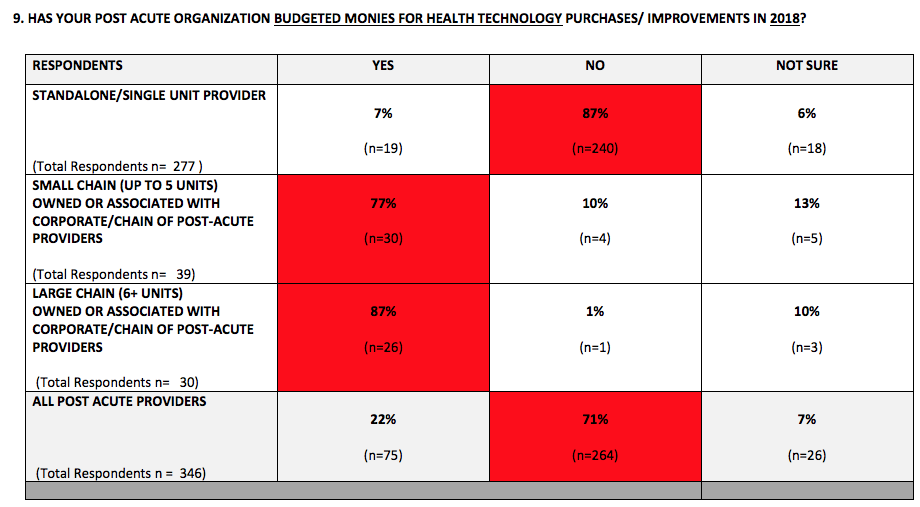Coordination between a skilled nursing facility (SNF) and other care providers is crucial for patients receiving post-acute care (PAC). However, many providers are still not leveraging the power of data analytics and the use of electronic health records (EHR) in this equation, according to a recent survey published by Tampa-based market research firm Black Book.
In a survey of 2,068 providers of long-term and post-acute care—including SNFs, short-term rehabilitation facilities and home health services, among others—only 19% of inpatient PAC providers reported having some technological capabilities of EHRs operational in the fourth quarter of 2017. This is compared to 15% in a year-over-year analysis.
The slow adoption rate can be attributed to the varying levels of technology investment and “conflicting cultural priorities” among providers, according to Black Book. Further, the firm found that 91% of PAC administrators reported having no funds in their budget for technology improvements in the past calendar year.
The issue will persist into 2018, with 87% of standalone/single-unit providers saying there is no money budgeted for health technology purchases. The situation is significantly better for small and large chains, with the majority of those types of providers allocating money for tech in the coming year.
“Long-term care facilities are still excluded from operating in a deeply connected care continuum due to limited resources and communication channels,” Doug Brown, managing partner of Black Book, said in a press release.
Lack of interoperability
Leveraging data from EHRs can lead to more defined care coordination, lower costs of care and a reduction in unnecessary readmissions.
However, only 3% of inpatient long-term care providers reported having the ability to utilize data-driven analytics, according to the Black Book research.
Further, long-term care administrators reported that 86% of their facilities are not exchanging health information electronically with home health providers and other referring agencies. This disconnect between the PAC world and the rest of the care continuum has not improved in recent years, according to Brown.
“Finding ways to improve communications between disparate acute care EHRs and post-acute technology is a pressing problem for detached providers,” he said.
In fact, this lack of information technology is considered among the most pressing issues plaguing the PAC industry going into 2018.
A total of 64% of SNFs surveyed consider lack of information technology the most pressing issue, while 84% of home health companies surveyed share the same sentiment. In addition, 83% of SNFs said that their organization’s information technology and electronic patient data exchanges are currently “non-existent or extremely poor.”
The lack of communication is “an extremely expensive problem,” particularly as hospitals become financially responsible for patients’ long-term outcomes, according to Brown.
Black Book predicts remote monitoring and video visits will be the temporary solution to allowing hospitals to track patients after discharge until the post-acute care facilities find ways to afford technology with connectivity.
Written by Carlo Calma





